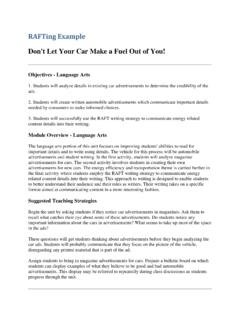Transcription of Performance Assessment Examples from the Quality ...
1 IssuestopicsaboutTHome / Issues / 47 Performance Assessment Examples from theQuality Performance Assessment Networkby Christina KuriacoseFour Examples spanning grade levels and disciplines demonstrate therange and possibilities of Performance Assessment . These exampleswere compiled by Christina Kuriacose, Program Associate, QualityPerformance Assessment , Center for Collaborative following performanceassessments are strongexamples of teacher-developed performanceassessments from schools within the Centerfor Collaborative Education s QualityPerformance Assessment network.
2 Theseperformance tasks demonstrate thepedagogical decisions teachers made, aswell as the ways the experience allowed fordeeper learning. While these summaries do not address the fullcurriculum, expectations, or teaching context in which the tasks areembedded, they do offer a consistent format to explore task details andlearn more about work resulting from teacher-created, OF KNOWLEDGE LEVELST hese Performance Assessment Examples refer to Depth ofKnowledge Levels from Quality Performance Assessment , whichare:Depth of Knowledge 1: Recall; memorization; simpleunderstanding of a word or phrase.
3 Appears 47 Performance Assessment :A Deeper Look at Practiceand ResearchThis issue is an onlinesupplement to VUE 46,which addressed the topicof performanceassessment apersonalized and rigorousalternative to standardizedtesting that allows teachersto build on individualstudents strengths andfoster more equitablelearning outcomes. VUE 47 adds additionalcurrent materials, offersopportunities for additionalvoices, and provides moreexamples of performanceassessment. Becauseperformance Assessment isan active nationalconversation, the workcontinues; following VUE46 s publication, importantnational conferences andother milestones occurredthat we re able to sharehere.
4 This issue alsoprovides perspectives fromstudents, educators,researchers, issue as PDFP urchase print copies Depth of Knowledge 2: Covers level 1 plus: paraphrase;summarize; interpret; infer; classify; organize; compare; anddetermine fact from fiction. There is a correct answer, but mayinvolve multiple of Knowledge 3: Students must support their thinking byciting references from text or other sources. Students are asked togo beyond the text to analyze, generalize, or connect deeper knowledge. Items may require abstract reasoning,inferences between and across readings, application of priorknowledge, or text support for an analytical judgment about a of Knowledge 4: Requires higher-order thinking, includingcomplex reasoning, planning, and developing of concepts.
5 Usuallyapplies to an extended task or project. Examples : evaluates severalworks by the same author; critiques an issue across time periods orresearches topic/issue from different perspectives; longerinvestigations or research for Assessment example 1 BackgroundYour Community Project: Understanding and Describing a CommunitySchool: Plymouth Elementary School, Plymouth, NHGrade level: 1 Content area: Social Studies, ELAT eacher Authors: Sarah Carlson, Kristen Kilduff, and Karen McLoudPlymouth Elementary School, part of SAU 48 in New Hampshire,entered Performance Assessment work by focusing on assessmentliteracy.
6 Over three years, the school s professional development planfocused on building the full staff s capacity to design, validate, andimplement Performance assessments. As part of their collaborativepractice, Plymouth teachers engage in monthly validation sessions thatare facilitated by a volunteer group of teachers. Incorporating feedbackis a key focus as the faculty members build their Assessment Elementary School is also a Tier 2 (building capacity)member of New Hampshire s Performance Assessment for CompetencyEducation (PACE), a statewide initiative in which member districts andschools are exempt from most state standardized testing and useteacher-generated local and common Performance assessments in itsplace to assess student learning.
7 Beginning in the 2017-2018 schoolyear, the school will become a Tier 1 PACE school; the PACE Performance Assessment system becomes their state accountabilityRelated contentPerformance-BasedAssessment: Meeting theNeeds of Diverse LearnersSeizing the Opportunity forPerformance Assessment :Resources and StatePerspectivesThe Future Is PerformanceAssessmentGreenTalks at Boston GreenAcademy: Student Reflectionson Performance AssessmentCase Study: The New YorkPerformance StandardsConsortiumSearch TaskThe Your Community task is designed to help students see the diversityof people, places, and things that are included in communities.
8 Aftercompleting a unit on the community, students draw a picture of acommunity, real or imagined. They are asked to include and labelpeople, buildings, animals, and nature. Once the maps are completed,students present their maps to the class, explaining how people use thedifferent spaces in their communities, what makes their communityinviting or uninviting to live in, and what people do in their : What is a community?Genre: Social Studies and ELAD epth of Knowledge: 3 requires students to synthesizeinformation from multiple texts and develop a complex modelHabits/Skills/DispositionsCommunica tionCreativitySelf-DirectionVoice and Choice: Students create their own communitiesAudience: Classmates and teacherTime Frame.
9 Three weeks, including current reading unit, thedrawing process, and the presentation processTeacher observation on the Your Community Performance task The prior unit fell around Thanksgiving and Christmas time, so we hadbeen focusing on community in general. Starting in October, we learnedabout community helpers. For Thanksgiving, we participated in creatingcenterpieces for lunches. We were active in our community, not justlearning about community. I had told the students we would be creatingour own communities later in the unit, but halfway through the communityunit, they were already asking to create their own.
10 When I introduced thetask, they cheered! Performance Assessment example 2 BackgroundBuilding Bold Bills: Integrating Civics into Persuasive WritingDaniel J. Bakie Elementary School, Kingston, NHGrade level: 4 Content area: ELA and Social StudiesNels Tooker, Kathleen McLaughlin, and Jillian ZeebenBakie Elementary School is part of the Sanborn School District in NewHampshire. Sanborn is a vanguard district in New Hampshire in termsof competency-based education (competency-based education sets broadlearning targets of what students should know and be able to do;students progress as they demonstrate proficiency over them), and wasone of the initial districts in the founding cohort of NH PACE 2012, Sanborn has been hosting a summer symposium oncompetency-based learning, inviting schools from all over the state andbeyond to attend.















